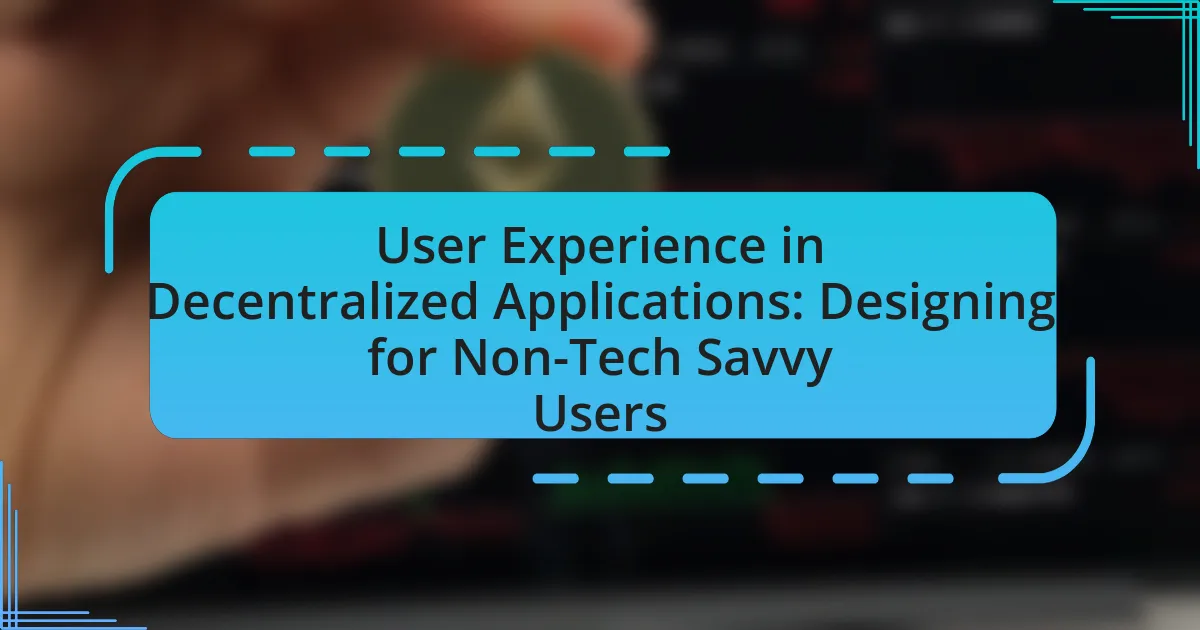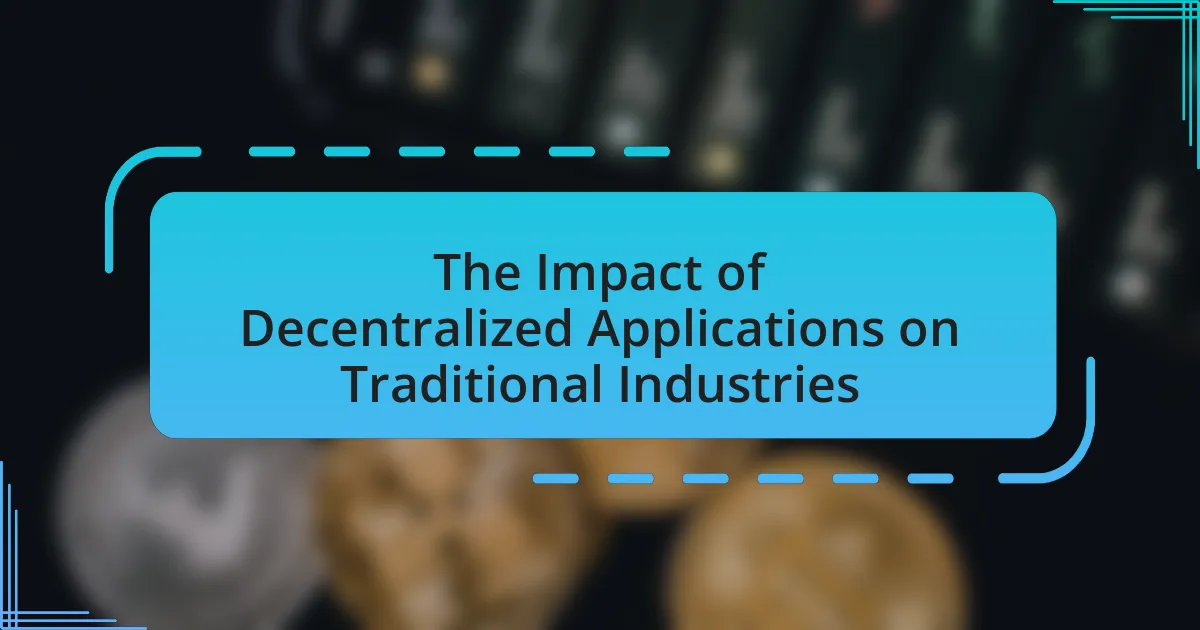Smart contracts are self-executing agreements coded on blockchain technology, playing a vital role in decentralized applications (dApps) by enabling trustless transactions and automating processes. This article explores how smart contracts function within dApps, the programming languages used for their creation, and their advantages in enhancing security, transparency, and efficiency. It also addresses the challenges and risks associated with smart contracts, including security vulnerabilities and interoperability issues, while highlighting best practices for users to ensure reliability. Additionally, future trends such as increased interoperability and the integration of artificial intelligence are discussed, showcasing the evolving landscape of smart contracts in decentralized ecosystems.
What are Smart Contracts and Their Role in Decentralized Applications?
Smart contracts are self-executing contracts with the terms of the agreement directly written into code, operating on blockchain technology. They facilitate, verify, and enforce the negotiation or performance of a contract without the need for intermediaries. In decentralized applications (dApps), smart contracts play a crucial role by enabling trustless transactions and automating processes, which enhances security and efficiency. For instance, Ethereum, a leading blockchain platform, utilizes smart contracts to power various dApps, allowing developers to create decentralized finance (DeFi) solutions, games, and more, all governed by transparent and immutable code. This functionality is supported by the fact that smart contracts eliminate the risk of manipulation and reduce transaction costs, making them integral to the operation of decentralized ecosystems.
How do Smart Contracts function within Decentralized Applications?
Smart contracts function as self-executing agreements with the terms directly written into code within decentralized applications (dApps). They automate processes by executing predefined actions when specific conditions are met, eliminating the need for intermediaries. For example, in Ethereum-based dApps, smart contracts facilitate transactions, manage digital assets, and enforce rules without human intervention, ensuring transparency and security. This functionality is validated by the Ethereum blockchain’s ability to execute millions of smart contracts, demonstrating their reliability and efficiency in decentralized ecosystems.
What programming languages are commonly used to create Smart Contracts?
Solidity and Vyper are the most commonly used programming languages for creating smart contracts, particularly on the Ethereum blockchain. Solidity is a statically typed language designed specifically for developing smart contracts, while Vyper is a newer language that emphasizes simplicity and security. Both languages are tailored to the Ethereum Virtual Machine (EVM), which executes smart contracts on the Ethereum network, making them essential for developers in this ecosystem.
How do Smart Contracts ensure trust and security in transactions?
Smart contracts ensure trust and security in transactions by automating and enforcing agreements through code on a blockchain. This automation eliminates the need for intermediaries, reducing the risk of fraud and manipulation. The decentralized nature of blockchain technology ensures that once a smart contract is deployed, it cannot be altered, providing a tamper-proof environment for transactions. Additionally, the transparency of blockchain allows all parties to verify the terms and execution of the contract, further enhancing trust. According to a report by the World Economic Forum, smart contracts can significantly reduce transaction costs and increase efficiency, demonstrating their effectiveness in securing transactions.
What advantages do Smart Contracts provide to Decentralized Applications?
Smart contracts provide several advantages to decentralized applications, including automation, transparency, and security. Automation allows smart contracts to execute predefined actions without human intervention, reducing the risk of errors and increasing efficiency. Transparency is achieved through the public nature of blockchain technology, enabling all participants to verify transactions and contract terms, which fosters trust among users. Security is enhanced as smart contracts are immutable once deployed, making them resistant to tampering and fraud. These advantages contribute to the overall reliability and effectiveness of decentralized applications in various sectors.
How do Smart Contracts reduce costs and increase efficiency?
Smart contracts reduce costs and increase efficiency by automating processes and eliminating intermediaries. By executing predefined conditions automatically on a blockchain, smart contracts minimize the need for manual intervention, which reduces labor costs and the potential for human error. For instance, a study by Deloitte found that smart contracts can reduce transaction costs by up to 30% in certain industries by streamlining operations and enhancing transparency. Additionally, the speed of execution in smart contracts leads to faster transactions, further increasing operational efficiency.
What impact do Smart Contracts have on transparency and accountability?
Smart contracts significantly enhance transparency and accountability in decentralized applications by automating and enforcing agreements through code. This automation ensures that all parties have access to the same information, as the contract’s terms are recorded on a public blockchain, making them immutable and verifiable. For instance, a study by the World Economic Forum indicates that smart contracts can reduce fraud and increase trust among users by providing a clear, auditable trail of transactions. This transparency minimizes the risk of manipulation and fosters accountability, as all actions taken under the contract are publicly accessible and cannot be altered without consensus.
How do Smart Contracts interact with Blockchain Technology?
Smart contracts interact with blockchain technology by executing self-enforcing agreements directly on the blockchain, which ensures transparency and immutability. These contracts are coded protocols that automatically enforce and execute terms of a contract when predefined conditions are met, eliminating the need for intermediaries. The interaction occurs on platforms like Ethereum, where smart contracts are stored on the blockchain, allowing for decentralized applications to function securely and reliably. This integration enhances trust among parties, as all transactions are recorded on the blockchain, providing an auditable and tamper-proof history of actions taken.
What is the relationship between Smart Contracts and Blockchain networks?
Smart contracts are self-executing contracts with the terms of the agreement directly written into code, and they operate on blockchain networks, which provide a decentralized and immutable ledger for recording transactions. The relationship is foundational; smart contracts leverage the blockchain’s security and transparency to automate and enforce agreements without intermediaries. For instance, Ethereum, a prominent blockchain network, was specifically designed to support smart contracts, enabling developers to create decentralized applications that execute automatically when predefined conditions are met. This integration enhances trust and efficiency in transactions, as the blockchain ensures that once a smart contract is deployed, it cannot be altered, thus safeguarding against fraud and manipulation.
How do Smart Contracts leverage Blockchain’s decentralized nature?
Smart contracts leverage blockchain’s decentralized nature by enabling self-executing agreements without the need for intermediaries. This decentralization ensures that the contract’s terms are immutable and transparent, as they are recorded on a distributed ledger accessible to all participants. Consequently, the risk of manipulation or fraud is significantly reduced, as no single entity controls the contract’s execution. The Ethereum blockchain, for example, allows developers to create smart contracts that automatically enforce agreements based on predefined conditions, demonstrating the practical application of this decentralized framework.
What are the limitations of Smart Contracts on different Blockchain platforms?
Smart contracts face several limitations across different blockchain platforms, including scalability issues, interoperability challenges, and security vulnerabilities. Scalability is a significant concern, as many platforms struggle to process a high volume of transactions quickly; for instance, Ethereum can experience congestion, leading to increased gas fees and slower transaction times. Interoperability is another limitation, as different blockchain networks often operate in silos, making it difficult for smart contracts to communicate or share data across platforms. Additionally, security vulnerabilities, such as coding errors or exploits, can lead to significant financial losses; the DAO hack on Ethereum in 2016, which resulted in the loss of $60 million, exemplifies this risk. These limitations hinder the full potential of smart contracts in decentralized applications.
How do Smart Contracts facilitate automation in Decentralized Applications?
Smart contracts facilitate automation in decentralized applications by executing predefined conditions automatically without the need for intermediaries. This self-executing nature allows for trustless transactions, where the code governs the agreement, ensuring that actions are performed only when specific criteria are met. For instance, in a decentralized finance (DeFi) application, a smart contract can automatically execute a trade when the price reaches a certain threshold, eliminating the need for manual intervention. This automation reduces the risk of human error and enhances efficiency, as transactions can occur instantly and continuously, reflecting the real-time state of the blockchain.
What processes can be automated using Smart Contracts?
Smart contracts can automate various processes, including financial transactions, supply chain management, and identity verification. In financial transactions, smart contracts facilitate automatic payments upon meeting predefined conditions, reducing the need for intermediaries. In supply chain management, they enable real-time tracking and verification of goods, ensuring transparency and efficiency. For identity verification, smart contracts can securely manage and authenticate user identities without manual intervention. These capabilities enhance operational efficiency and reduce costs across multiple sectors.
How does automation enhance user experience in Decentralized Applications?
Automation enhances user experience in Decentralized Applications (dApps) by streamlining processes and reducing the need for manual intervention. Smart contracts, which are self-executing contracts with the terms directly written into code, automate transactions and interactions within dApps, ensuring that actions are executed promptly and accurately without human error. This automation leads to faster transaction times, increased reliability, and improved security, as users can trust that the contract will perform as intended without the risk of manipulation. For instance, a study by the World Economic Forum indicates that smart contracts can reduce transaction costs by up to 30%, thereby enhancing overall user satisfaction and engagement in decentralized ecosystems.
What are the challenges and risks associated with Smart Contracts?
Smart contracts face several challenges and risks, including security vulnerabilities, legal enforceability, and lack of interoperability. Security vulnerabilities arise from coding errors or exploits, as evidenced by incidents like the DAO hack in 2016, where a flaw in the smart contract code led to the loss of $60 million in Ether. Legal enforceability is a concern because the legal status of smart contracts varies by jurisdiction, potentially complicating dispute resolution. Additionally, lack of interoperability between different blockchain platforms can hinder the seamless execution of smart contracts across networks, limiting their functionality and adoption.
What common vulnerabilities exist in Smart Contracts?
Common vulnerabilities in smart contracts include reentrancy, integer overflow and underflow, gas limit and loops, timestamp dependence, and improper access control. Reentrancy occurs when a contract calls another contract and allows the second contract to call back into the first contract before the first call is finished, potentially leading to unexpected behavior. Integer overflow and underflow happen when arithmetic operations exceed the maximum or minimum limits of data types, causing unintended results. Gas limit and loops can lead to transactions failing if they exceed the gas limit, especially in contracts with unbounded loops. Timestamp dependence arises when contracts rely on block timestamps for critical logic, which can be manipulated by miners. Lastly, improper access control can allow unauthorized users to execute functions that should be restricted, leading to security breaches. These vulnerabilities have been documented in various incidents, such as the DAO hack in 2016, which exploited reentrancy, resulting in a loss of $60 million worth of Ether.
How can developers mitigate risks when creating Smart Contracts?
Developers can mitigate risks when creating Smart Contracts by implementing thorough testing and auditing processes. Rigorous testing, including unit tests and integration tests, ensures that the contract functions as intended under various scenarios. Additionally, engaging third-party auditors to review the code can identify vulnerabilities and potential exploits, as evidenced by the increased security of audited contracts compared to unaudited ones. Furthermore, using established frameworks and libraries, such as OpenZeppelin, can reduce the likelihood of introducing errors, as these resources are widely vetted by the developer community.
What role do audits play in ensuring Smart Contract security?
Audits play a critical role in ensuring Smart Contract security by systematically identifying vulnerabilities and flaws in the code before deployment. These audits involve thorough reviews by experienced professionals who analyze the Smart Contract’s logic, functionality, and security measures. For instance, a study by ConsenSys Diligence highlights that over 70% of Smart Contracts have at least one vulnerability, underscoring the necessity of audits to mitigate risks. By detecting issues such as reentrancy attacks or improper access controls, audits help prevent potential exploits that could lead to significant financial losses or system failures.
How can users ensure the reliability of Smart Contracts in Decentralized Applications?
Users can ensure the reliability of Smart Contracts in Decentralized Applications by conducting thorough audits and utilizing established frameworks. Auditing involves reviewing the code for vulnerabilities and ensuring compliance with best practices, which can significantly reduce the risk of exploits. For instance, a study by ConsenSys found that 70% of smart contracts contain vulnerabilities, highlighting the importance of rigorous testing and validation. Additionally, employing well-known frameworks like OpenZeppelin can provide pre-audited libraries that enhance security. By combining these strategies, users can increase their confidence in the reliability of smart contracts.
What best practices should users follow when interacting with Smart Contracts?
Users should follow several best practices when interacting with smart contracts to ensure security and efficiency. First, users must thoroughly review the smart contract code or rely on audited contracts to avoid vulnerabilities. According to a report by ConsenSys, 70% of smart contracts contain bugs, emphasizing the importance of scrutiny. Second, users should only interact with reputable platforms and projects, as many scams exist in the decentralized space. Research from Chainalysis indicates that over $2.8 billion was lost to scams in 2021 alone. Third, users should understand the terms and conditions of the smart contract, as they dictate the rules and potential risks involved. Lastly, users should keep their private keys secure and use hardware wallets when possible to protect their assets from unauthorized access.
How can users identify trustworthy Decentralized Applications utilizing Smart Contracts?
Users can identify trustworthy Decentralized Applications (dApps) utilizing Smart Contracts by examining the transparency of the code, the reputation of the developers, and the community engagement surrounding the application. Trustworthy dApps typically have their smart contracts audited by reputable third-party firms, ensuring that the code is secure and free from vulnerabilities. Additionally, users should look for dApps with a strong track record, positive user reviews, and active community discussions on platforms like GitHub or forums. Research indicates that dApps with higher transparency and community involvement tend to have lower instances of fraud and security breaches, reinforcing their reliability.
What future trends can we expect for Smart Contracts in Decentralized Applications?
Future trends for smart contracts in decentralized applications include increased interoperability, enhanced security measures, and the integration of artificial intelligence. Interoperability will allow smart contracts to function across multiple blockchain platforms, facilitating seamless transactions and data exchange. Enhanced security measures, such as formal verification, will ensure that smart contracts are free from vulnerabilities, reducing the risk of exploits. The integration of artificial intelligence will enable smart contracts to execute more complex logic and automate decision-making processes, improving efficiency and user experience. These trends are supported by ongoing advancements in blockchain technology and the growing demand for more robust decentralized solutions.
How might advancements in technology impact Smart Contracts?
Advancements in technology can significantly enhance the functionality and efficiency of Smart Contracts. For instance, improvements in blockchain scalability, such as the implementation of sharding or layer-2 solutions, can increase transaction speeds and reduce costs, making Smart Contracts more accessible for a wider range of applications. Additionally, the integration of artificial intelligence can enable Smart Contracts to execute more complex conditions and automate decision-making processes, thereby increasing their utility in various sectors like finance and supply chain management. Furthermore, advancements in cryptographic techniques can enhance security and privacy, ensuring that Smart Contracts are less vulnerable to attacks and fraud. These technological improvements collectively contribute to the broader adoption and effectiveness of Smart Contracts in decentralized applications.
What potential developments could enhance the functionality of Smart Contracts?
Potential developments that could enhance the functionality of Smart Contracts include the integration of artificial intelligence, improved interoperability between different blockchain platforms, and the implementation of formal verification methods. Artificial intelligence can enable Smart Contracts to execute more complex decision-making processes, allowing for dynamic responses to real-world events. Improved interoperability can facilitate seamless interactions between various blockchain ecosystems, expanding the use cases for Smart Contracts across different platforms. Formal verification methods can ensure the correctness of Smart Contracts by mathematically proving their behavior, thereby reducing vulnerabilities and increasing trust in their execution. These advancements collectively aim to make Smart Contracts more robust, versatile, and secure in decentralized applications.





